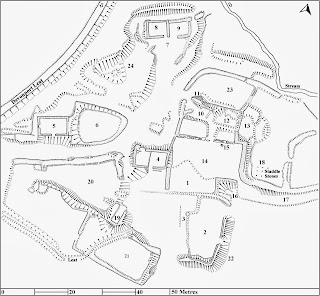BLACK TOR
The area surrounding Black Tor has in many
respects been neglected by both antiquarians and archaeologists over the years
and before starting the survey work here it was believed that apart from a
small lode-back tinwork very little else would be encountered. As the survey progressed it soon became
apparent that in the first place the tinwork was much more extensive than had
been previously appreciated. In addition, remains of prehistoric date, together
with those associated with stone quarrying and splitting and second world war
training have survived.
The survey work at Black Tor has
revealed a complex multi-period archaeological landscape in which industrial
activity appears to have played a prominent, although not exclusive part. The earliest activity
appears to relate to the prehistoric period and there are a number of features which
may belong to this time. The first are
four enclosures, none of which is complete.
Three of these lie on the upper slopes of the hill and the fourth lies
adjacent to the valley bottom. None of
these enclosures appear to be associated with round houses, although the
possibility of them having once contained timber structures cannot be entirely
ruled out. However, given their location
above the known settlement distribution, it does appear more likely that they
represent animal enclosures in which animals being released onto the open
moorland were corralled.
Three
discreet areas of tinwork earthworks survive on the sides of the hill, whilst
in the valley below there is an extensive alluvial streamwork and two mills in
which the tin was crushed and processed.
The three tinworks survive as lines of pits cutting into the back of the
lodes being explored or exploited. In later years Dartmoor 's
industrial workers turned to Black Tor again - this time in the search of stone
for building purposes. Stone extraction
in the area was always on a small scale, with surface stone being dug up and
carted away leaving small distinctive hollows.
The full survey report on the archaeology at Black Tor, Meavy Valley, Dartmoor was originally published in 1997 and is now available online. The report can be viewed here.









